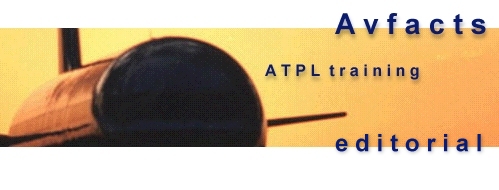General:
The EADI is sometimes called the Primary Flight Display (PFD). It replaces the Artificial
Horizon found in non-EFIS aircraft. It has a number of advantages over the older 'round
dial' display instrument such as:
- More reliable.
- More information can be portrayed.
- Improved readability due to larger, clearer colour
displays.
- Brightness is adjusted automatically to compensate for rapid
changes in cockpit lighting levels, such as when flying in and out of cloud.
Let's take a look at the 'snapshot'
displayed, and interpret what it is telling us.

Flight Modes:
These are shown along the top of the display. Active modes that the aircraft is flying in
are shown in green. Armed modes are shown in white letters below the active modes. In this
case the Autopilot is flying the aircraft, as witnessed by the "CMD"
annunciation in the top right corner. The autothrottle is engaged and it will fly the
aircraft at the speed set by the pilot's in the autopilot airspeed window of the autopilot
panel. You can see this by the green annunciations of "SPD" and
"A/T" in the top left hand corner of the screen.
The autopilot is flying the vertical and lateral profile entered into the Flight
Management System (FMS) by the pilots. This is witnessed by the green "VNAV
PTH", and "LNAV" annunciations in the top centre of the screen. Below the
active modes are the armed modes, which in this case are glideslope "G/S" and
localiser "LOC". When the FMC path has guided the aircraft to a capture of the
ILS localiser, and thereafter the ILS glideslope, these annunciations will appear in green
letters, replacing the "LNAV" and "VNAV PTH" annunciations. This
announces to the pilots that the autopilot has captured the localiser and glidepath.
Speed Annunciations:
These are shown down the left hand side of the EADI in both pointer and digital readout of
present airspeed. Speeds such as V1 and Vr speeds can be shown for easy reference. Below
the speed tape is the present Mach number supplied by the Central Air Data Computer
(CADC), and the present groundspeed as supplied by the Inertial Reference Units.
Localiser and Glideslope scales:
These are presented along the bottom and right hand side of the screen. They function in
the same way as do conventional LOC and G/S scales.
Decision Height:
This displays the value set by the pilots, and represents the Decision Height for that
particular ILS approach. When the decision height (agl) is reached the display flashes
momentarily in amber, then counts down the height agl until touchdown. After touchdown it
returns to white.
Flight Director bars:
In the B767 these are displayed as 'cross hairs'. They give guidance to the pilots as to
what pitch/roll manoeuvres will achieve the desired flightpath. For example, cues as to
bank angle to turn and capture a desired heading.
More information on the B767 aircraft autoflight
systems can be found in a book called "FLYING
GLASS", which is dedicated to training those pilots about to attempt the
Australian ATPL 'Aerodynamics & Aircraft Systems' examination, those preparing for
airline interviews or careers, or those just interested in how modern airliners get from A
to B. Over 100 multi-choice review questions will test your knowledge. Answers are
supplied, and quick page/paragraph references will assist in fine tuning your
understanding. Flying Glass is a
complete self study text and is featured in the CASA ATPL reference text list. It has been
used very successfully by Rob Avery's ATPL students for a number of years. It and
other ATPL training texts are now available from most pilot shops around Australia, or you
can purchases them through the aviationshop secure online store.
|










![]()